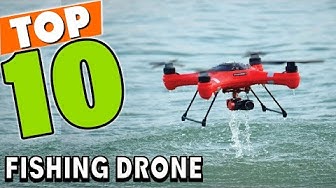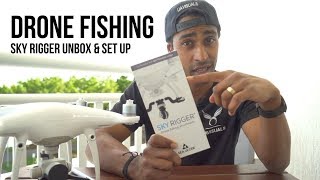
New Zealand's drone fishing has become a popular fishing method. This innovative new technique uses drone technology to open up new fishing opportunities. Drone Fishing NZ, a top retailer, offers the DJI and Splash drones for purchase. You can also find Splash drones and GoFish cameras, as well as custom-built fishing rigs.
Aerokontiki Drones
Sharkan offers a Fishhawk, a fishing drone that captures the action better. This drone's camera is stabilized and shoots 12-megapixel photos and 4k UHD videos at 30 frames per second. The videos can be viewed on your smartphone. The drone offers a range of good transmission and flight time, as well as a spare batteries that can be charged.
Mobula
Mobula drones have been specifically designed for fishing. The drone's buoyancy and IP56 rating means it can withstand winds up to 20 km/h. It also includes safety features such an automatic return home, automatic release of payload, and three release methods. Your drone will automatically return back to the water when its battery goes flat. This means you won't have any worries about it getting lost.
Banks'
Fishing drones have become a hugely popular trend that has attracted the attention of both anglers as well as sports enthusiasts. A drone can present its own set of challenges. The drone is not recommended for fishing in shallow water. A second problem arises when a drone crashes in the same location a second time. You can't always rely on the information in the video if that happens.

SplashDrone 4
Swellpro's SplashDrone 4 drone is waterproof and comes with a new float platform. The drone can be used for fishing parties or other water-related activities. It is made from corrosion-resistant materials, as well as industrial-grade ABS to withstand the most severe conditions. Smooth+ is the SplashDrone 4’s exclusive flight control system. This gives the user full control over the drone and keeps it stable in any environment. Its advanced technology allows it to capture every angle and every moment from the sky.
Drone for fishermen
If you're a New Zealand Fisherman Drone fisherman, then you're in for a real treat. Snapper is a sought-after species for drone fishermen. They are beautiful and tasty, making them a delight to catch. These fish are often found near the North and South island coasts. They often congregate during the springtime when they spawn. You'll be able to catch these fish throughout the summer months, as well, as they are plentiful in the fall.
Flying a drone
To ensure your drone fishing trip in New Zealand is a success, you need to follow these guidelines. You must be familiar with the law. It is against the law to fly your drone over marine life, or within 500 metres of any marine mammal. You'll also need to be mindful of your surroundings when flying your drone, as you don't want your expensive drone confiscated or damaged.
Payload for a drone
While you can purchase a drone for fishing purposes, be mindful of its payload. You need a drone that is strong enough to lift heavy fish and long-lasting flight. If you plan on using your drone only for a few minutes, chances are you won't catch enough fish to make it worthwhile. Luckily, the technology behind drone fishing in New Zealand is getting better.

FAQ
How do you travel with a drone?
Drones are becoming more popular, both for personal and business purposes. They are used for video, filming aerial mapping, search &rescue, and many other purposes. The FAA has recently approved several new drone regulations, which include requirements for registration, licensing, pilot training, and insurance. These modifications will ensure that drones remain safe and secure for all involved.
What's the difference between quadcopters and hexacopters?
Quadcopters are four-rotor helicopters that fly like traditional helicopters. It has four rotating rotors. A quadcopter has four rotors. The hexacopter has six. Hexacopters can be more stable and maneuverable that quadcopters.
Do drones fall under the control of the FAA?
The FAA supervises all aspects related to drone operations, including certification requirements and safety standards.
Can I fly my drone around my area?
Yes! These are called UAVs (unmanned aircraft vehicles). There are many options for drones, from small quadcopters to larger fixed-wing aircraft. The FAA has recently issued new rules regarding the commercial use of UAVs, which means you can now legally fly them for business purposes. It is important to remember that UAVs are not allowed near airports.
Do I need to be able to fly a drone without special training?
No, you don’t have to learn any special skills in order for your drone to fly. All you need is a remote control unit and some basic knowledge of flight mechanics.
Statistics
- According to Indeed, a drone pilot gets paid $25.73 per hour on average in the US. (dronesgator.com)
- Research and Markets predict a growth rate of 51.1% over the next five years. (thedroneu.com)
- According to industry research from ZipRecruiter , there are 10 cities where the typical salary for a Drone Pilot job is above the national average. (dronesgator.com)
External Links
How To
How to Fly Drones at a Beginning Level
A drone is an unmanned aerial vehicle that can be remotely controlled and used for surveillance, aerial photography, film production, research, and other hobby purposes. Drone technology has existed since World War II. DJI's Phantom quadcopters became commercially available in 2010. Since then, there have been many different types of drones available, from beginner-friendly models like the Parrot AR Drone 2.0 to professional-grade multi-rotor craft like the DJI Mavic Pro.
You can fly a drone in many different ways, including:
-
Remote control: This uses a remote control device that attaches to your hand and allows you control the drone along its flight path. There are two main types, On/Off switches (like radios) and joysticks.
-
Manual Control- This allows you to control your drone remotely via GPS coordinates. You will need to keep track of where the drone is going and follow the directions from the app.
-
Autonomous Flying - This allows the drone to take over all of the piloting duties. It is basically flying autonomously and without human intervention. A drone must have a builtin camera and sensors capable to capture images and other data.
-
Triggered Flying - This method works in the same way as manual control. However, the pilot has to manually set up a route for the drone and it follows that route until reaching the endpoint. Once the programmed route has been completed, the drone returns to the base automatically.
-
Landing Gear – A few drones come with landing gear. This allows them land safely in the event of losing power or running out of battery.
-
Goggles - Pilots may wear goggles to shield themselves from flying debris.
-
Camera - Some drones can be equipped with cameras which enable you to capture photos from the sky.
-
Obstacles. Some drones can have obstacle avoidance technology that stops them from hitting obstacles.
-
Speed – Some drones can reach speeds in excess of 40 mph.
-
Battery Life - Most drones can last between 20 minutes to 3 hours, depending on how much power you're using.
-
Some drones have a range of up to 30 miles, depending on their model.
-
Power source: Some drones will require an external power source while others can be powered by internal batteries.
-
Weight - Some drones have a weight of less than 1 pound and others weigh 4 lbs.
-
Size - Drones range from small devices that fit in one's palm to large crafts that weigh more than 50 pounds.
-
Price - From high-end models that cost thousands of dollars to low-cost options that start at $100, all drones fall under a certain price category.